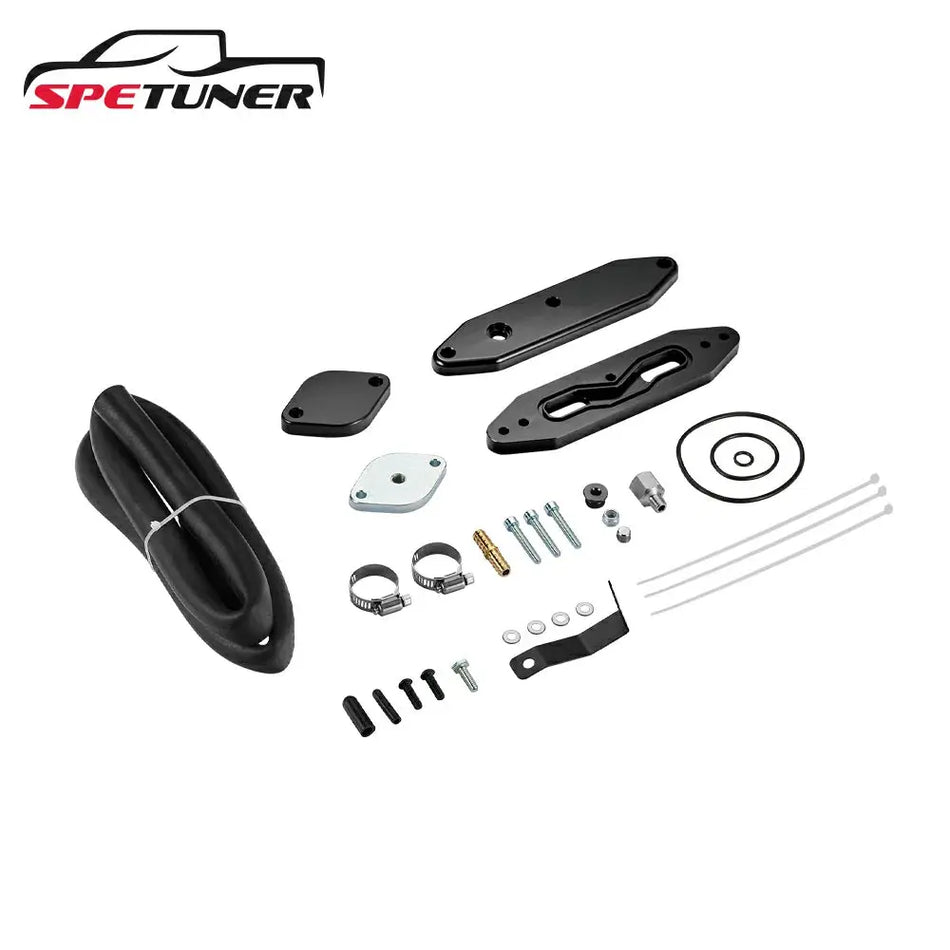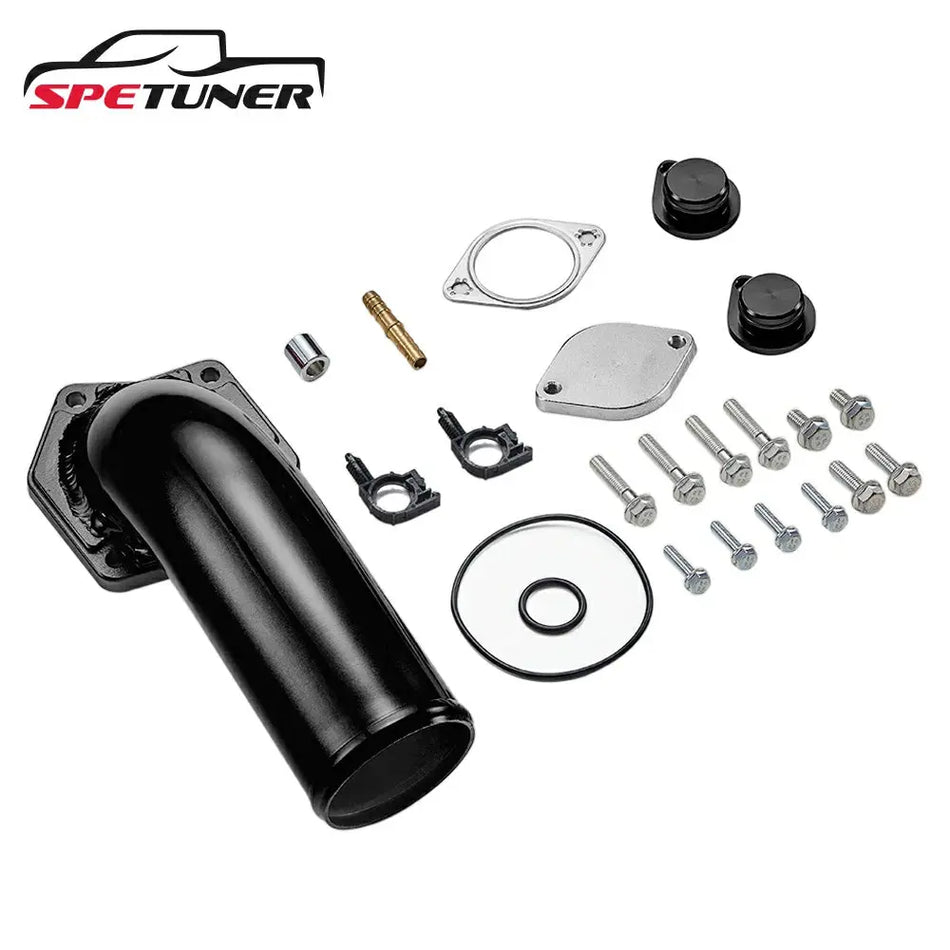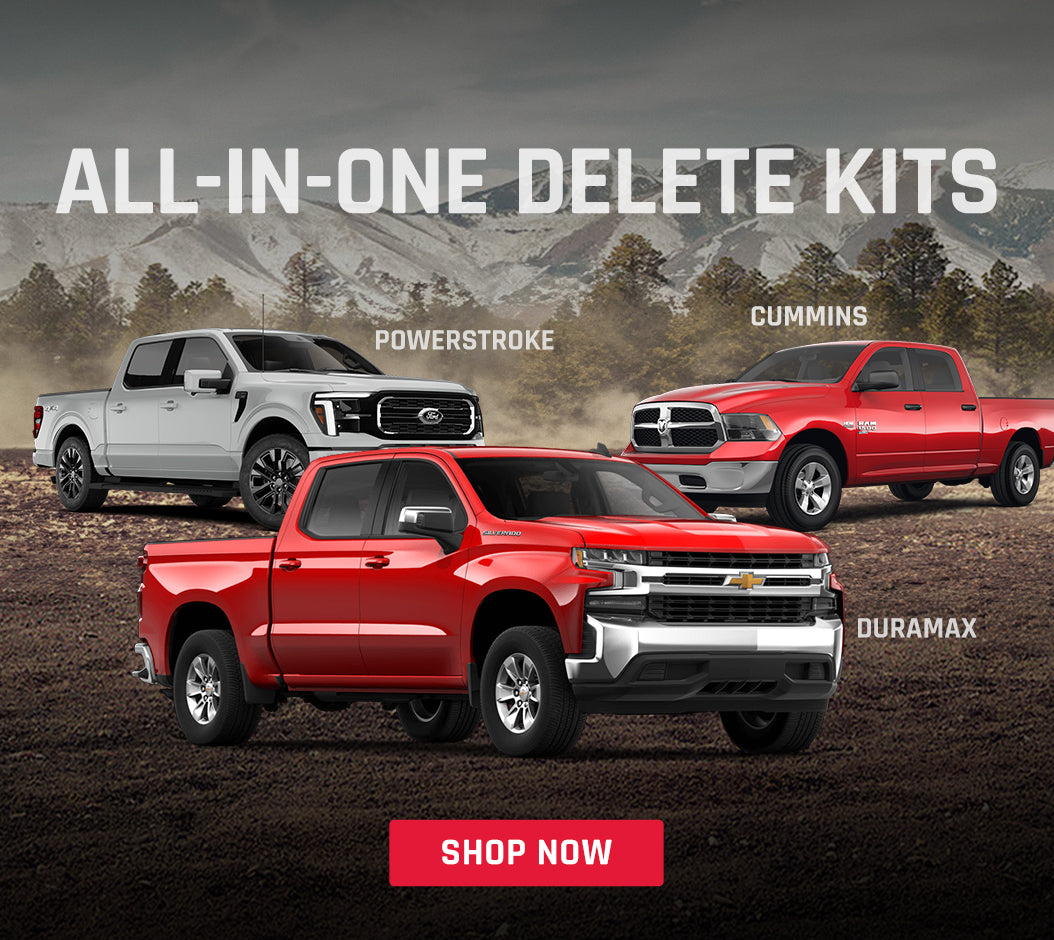Common Oil Leak Issues in 6.7L Cummins Engines
Let’s face it—if you own a 6.7L Cummins, you’ve probably noticed some oil where it shouldn’t be. These engines are workhorses, but even the toughest setups aren’t immune to leaks. The good news? Most of these oil leaks come from just a few usual suspects. Here’s what you need to watch for:
1. Valve Cover Gasket Leaks
This is one of the most common points for oil leaks on the 6.7 Cummins. Over time, the rubber gasket under the plastic valve cover hardens or shrinks, causing it to lose its sealing ability. Once that happens, oil starts seeping down the sides of the engine.
Signs to look for:
- Oily residue around the top of the engine
- Oil dripping near the high-pressure fuel lines
- Burning oil smell when the engine’s hot
Why it matters: Many people confuse this leak with a problem in the fuel system, but it’s just a tired gasket doing what old gaskets do—leaking.
2. Rear Main Seal Leaks (Crankshaft Seal)
This one’s a little more serious. The rear main seal is located between the engine and the transmission. When it starts to go bad, you’ll see oil collecting between the bellhousing and the oil pan.
Common symptoms:
- Drips under the center of the truck
- Wet-looking flywheel inspection cover
- Oil loss with no visible leaks up top
The catch? Fixing this requires separating the transmission, which is why many owners put it off until it gets worse.
3. Turbo Oil Drain Tube Leaks
Right under the turbo sits the oil drain line. It channels oil from the turbo back into the engine. If the O-rings on either end degrade, you’ll get a leak that’s often mistaken for a rear main seal problem.
Tell-tale signs:
- Oil on the back of the engine block
- Drips on the downpipe or exhaust
- Burning smell after shutdown
Tip: If you smell oil but the rear main seal looks dry, check the turbo drain first—it’s a common hidden culprit.
4. CCV Filter or Crankcase Pressure Issues
This one surprises many people. The Crankcase Ventilation (CCV) filter is often overlooked, but once it clogs up, it causes excess pressure inside the engine. That pressure forces oil out through weak spots, such as the valve cover, breather lines, or even the rear seal.
What to watch for:
- Oil stains around the CCV housing or breather tube
- Residue on the intake horn or intercooler pipe
- Excess blow-by or whistling from the engine bay
Here’s the deal: If your truck has over 60K miles and still has the factory CCV filter, it could very well be the root of your leak problems. That’s where a quality CCV Reroute Kit can make a real difference.
5. Oil Pan Gasket Leaks
While not as dramatic as a rear seal issue, the oil pan gasket can still make a mess. Age, vibration, and poor sealing surfaces can all lead to slow but steady leaks from the bottom of the engine.
Signs:
- Oil is building up around the pan edges
- Oil spots after long-term parking
- Accumulated grime underneath the pan
Pro tip: When replacing the gasket, always use a torque wrench and proper sealing technique—over-tightening is a common mistake.
Final Word on Oil Leak Troubleshooting
Oil leaks can be frustrating, especially when they all look the same from the outside. If you're chasing oil on your 6.7 Cummins, don't just wipe it off and hope for the best—track it down. Start with the valve cover, CCV filter, and turbo drain. These are the usual suspects and often the easiest fixes.
Need a more permanent solution for crankcase pressure issues? A SPETUNER CCV Reroute Kit might be the smartest upgrade you’ll ever bolt on.

What is a CCV Filter and Why Does It Matter in Cummins Engines
If you’ve popped the hood on your 6.7 Cummins and spotted that large black box sitting on top of the valve cover, that’s your CCV filter—short for Crankcase Ventilation filter. Although it may not seem significant, this small component plays a crucial role in how your engine handles oil vapors and internal pressure.
What the CCV System Does
Every diesel engine builds up pressure inside the crankcase as it runs—this pressure comes from combustion gases that sneak past the piston rings (known as blow-by). Left unchecked, that pressure can cause oil to leak out of seals and gaskets throughout the engine.
That’s where the CCV system comes in. It:
- Vents that relieve internal pressure safely
- Filters out oil mist from the vapor before it's routed back to the intake
- Keeps your engine from turning into a leaky mess
Why It’s Important on the 6.7L Cummins
On the 6.7 Cummins, the CCV system is more than just a vent—it’s a sealed, emissions-compliant setup. The CCV filter, located under the plastic cover on top of the valve cover, is designed to catch and separate oil particles from crankcase vapors before they’re routed back into the intake system.
Here’s where things start to go sideways:
Over time, the filter gets clogged with oil residue.
This increases crankcase pressure instead of releasing it.
And that excess pressure? It starts pushing oil out of weak points—your valve cover, intercooler piping, rear main seal, and even the turbo drain tube.
Bottom line: a clogged CCV filter is a silent killer. You won’t notice it until you’re wiping oil off your intake horn or finding drips on your driveway.
How Does the Filter Clog?
- Age: Factory CCV filters typically clog after 50,000–67,500 miles.
- Harsh driving conditions, such as towing, hot climates, and prolonged idle times, accelerate clogging.
- Neglect: Most owners are unaware of the filter's existence, let alone its replacement.
Once clogged, it restricts airflow and causes pressure to back up in the engine. And that’s when the oil leaks begin.
What Happens If You Ignore It?
- Progressive oil leaks at the valve cover, rear seal, or turbo
- Blow-by vapors in the intake, leading to carbon buildup
- Higher maintenance costs down the road from damaged seals
A strong, greasy burnt-oil smell under the hood
The longer you wait, the more damage it can cause—not just to your seals, but also to your turbo and EGR system.
If you’ve never replaced your CCV filter or are seeing unexplained oil seepage, it’s likely time to take a closer look at what’s happening under the valve cover.

Can the CCV Filter Cause Oil Leaks?
You might be wondering—can a filter cause all this mess? The short answer is: yes, and it happens more often than you think. In fact, for many 6.7 Cummins owners dealing with oil leaks, the CCV filter is the root cause hiding in plain sight.
What Happens When the CCV Filter Gets Clogged?
When the CCV filter becomes saturated with oil and soot over time, it stops venting crankcase pressure as it should. That pressure has to go somewhere, and if it can’t exit through the filter, it forces its way out through any weak spot it can find.
Here’s what typically follows:
- Oil pushed past the valve cover gasket
- Oily residue in the turbo piping and intercooler
- Drips forming under the rear main seal
- Breather tube leaving oil stains on the engine or firewall
The worst part? You might fix the valve cover, clean the intercooler pipe, or even replace your rear seal—but if you don’t fix the pressure buildup, the leaks will keep coming back.
How to Tell if Your CCV Filter Is to Blame
- Oil stains around the breather port or valve cover bolts
- Hissing or whistling sounds from the top of the engine
- Oil in the charge pipe or intercooler boots
- A strong blow-by smell under the hood after driving
If these signs sound familiar, chances are your CCV filter is clogged, and it’s time for a change—or better yet, a replacement.
Here’s the deal: A clogged CCV filter won’t just cause one oil leak—it’ll start a chain reaction. Fixing gaskets without addressing the pressure problem is like putting duct tape on a balloon that’s about to pop.
That’s why many Cummins owners now skip the filter replacement and opt for a SPETUNER CCV Reroute or Delete Kit—a cleaner, more permanent solution.
When and How Often Should You Change the CCV Filter?
This question pops up all the time:
“How often should I change the CCV filter on my 6.7 Cummins?”
The answer depends on how you drive, but here's the truth most owners don’t hear: you might be running with a clogged filter and not even know it.
Recommended CCV Filter Change Interval
According to RAM’s service guidelines, the CCV filter on a 6.7 Cummins should be replaced every 67,500 miles. That’s the “safe” number—but in the real world, that interval doesn’t always hold up.
Here’s what we’ve seen in practice:
- Heavy towing or hot climates? Change it closer to 40,000–50,000 miles
- Long idle times or city driving? Even 30,000–40,000 miles may be too long
- Mods or tuning installed? The engine produces more blow-by, so filters clog faster
If you’ve passed 50K miles and never looked at it, you’re already on borrowed time.
What Happens If You Don’t Change It?
The longer you wait, the worse it gets. Here’s what a neglected CCV filter leads to:
|
Problem |
What You’ll Notice |
|
Crankcase pressure buildup |
Oil leaks at the valve cover, rear main, or turbo piping |
|
Oil in the intake system |
Reduced turbo efficiency, intercooler contamination |
|
Increased engine wear |
Poor sealing, blow-by gases stuck in the system |
|
Higher maintenance costs |
Replacing gaskets or seals that didn’t need to fail |
How Do You Know It’s Time to Replace the Filter?
Even if you don’t track your mileage to the mile, your engine will usually tell you it’s time:
- You’re wiping oil off the intake horn or turbo pipe
- The engine bay smells like hot oil
- You notice sludge around the CCV box
- Oil starts showing up in unexpected places, like intercooler boots
And here’s the kicker: Most of these signs show up well before that “67,500-mile” mark.
So, What Should You Do?
You’ve got two solid options:
Stick with OEM:
Buy a replacement CCV filter and replace it every 50,000 miles or so. Not too hard, but costs add up over time, especially if you’re a high-mileage driver.
Upgrade with a Reroute/Delete Kit:
A SPETUNER CCV Reroute Kit eliminates the need for filter replacements entirely. It safely vents crankcase gases, routes oil vapor away from the intake, and completely prevents CCV-related pressure buildup.
Bottom line: If you want to stop leaks, reduce blow-by buildup, and avoid repeated CCV maintenance, a delete kit is the more brilliant long-term move, especially if you’re running your Cummins hard.
How to Replace the CCV Filter on a 6.7 Cummins
So, you’ve figured out your CCV filter might be clogged, and now you're ready to replace it. Good call. Whether you're performing routine maintenance or trying to stop a pesky oil leak, swapping out the filter is a relatively simple job that most diesel DIYers can complete in under an hour.
Let’s walk through it step by step.
Tools & Parts You’ll Need
- Replacement CCV filter (OEM or upgraded)
- 8mm and 10mm socket or nut driver
- Torque wrench (optional, but recommended)
- Shop towels (you’re gonna want them)
- Light degreaser or brake cleaner (optional cleanup)
Step-by-Step CCV Filter Replacement Guide
Step 1: Disconnect the Battery (Optional but Safe)
Not required, but always a good habit when working near sensors or wiring.
Step 2: Remove Engine Cover
If your truck still has the factory plastic engine cover, remove it. It usually just pops up and out of the way.
Step 3: Locate the CCV Filter Housing
It’s the large black box directly on top of the valve cover. You’ll see several bolts securing it.
Step 4: Remove CCV Filter Bolts
Use your socket to remove the 8mm or 10mm bolts. Keep them safe—you’ll reuse them.
Step 5: Gently Lift Off the Filter Housing
It might stick due to old sealant or vacuum, so lift evenly from all sides.
Step 6: Remove the Old Filter
The filter may come out with the housing or remain seated on the valve cover. Either way, lift it straight up and out. Be prepared for a bit of oil residue.
Step 7: Clean the Mating Surfaces
Wipe down the top of the valve cover and inside the housing with a clean rag. Don’t let any debris fall into the engine.
Step 8: Install the New Filter
Drop the new filter into place. Ensure it’s properly aligned and fully seated.
Step 9: Reinstall the Housing
Place the housing back over the new filter and tighten the bolts evenly. Don’t overtighten—snug them down.
Step 10: Reinstall the Engine Cover and Start the Truck
Fire it up, let it idle, and check for leaks or unusual noises. You're good to go.
Lars’ Tips from the Bay:
If you see oil pooling in the housing when you remove the old filter, that’s a strong sign it’s overdue.
If the old filter looks like a sludgy black sponge, you waited too long—but don’t worry, now’s the right time to fix it.
Want to skip this step forever? Upgrade to a SPETUNER CCV Reroute Kit and eliminate the need for replacement intervals.
Not every oil leak starts from the CCV filter, but when it does, this quick fix can save you hundreds in unnecessary gasket and seal replacements later.

Should You Delete the CCV Filter? Pros & Cons
If you're tired of oil leaks, clogged filters, or just sick of cracking that valve cover open every 50K miles, you've probably asked yourself:
“Should I just delete the CCV filter altogether?”
You're not alone—thousands of 6.7 Cummins owners have opted for the delete route, especially those who drive hard, tow frequently, or want a cleaner, lower-maintenance engine bay.
But like any mod, there are trade-offs. Let’s break it down.
✅ Benefits of a CCV Filter Delete (Reroute Kit)
1. Say goodbye to pressure-induced oil leaks
Deleting the CCV filter vents crankcase pressure directly out of the engine, instead of sending it through a clogged or restrictive filter. This helps:
- Reduce gasket stress
- Prevent rear main seal and valve cover leaks
- Eliminate oily blow-by buildup in your intake and turbo piping
2. No more filter replacements
Reroute once and you’re done. No 67,500-mile service intervals. No guessing if your filter’s clogged. Just clean, open ventilation.
3. Cleaner intake and turbo system
By venting oil vapor externally (instead of recycling it back into the turbo), your intercooler, charge pipes, and EGR system remain cleaner, especially helpful if you’re tuned or have deleted components.
4. Simple install and low maintenance
A good reroute kit (like the SPETUNER CCV Delete Kit) uses high-temp silicone hose and clamps. Installation typically takes 30–45 minutes, and the result is permanent.
Potential Drawbacks You Should Know
1. Visible vapor discharge
Since the vapor now exits through a hose routed under the truck, you may notice a slight amount of smoke at idle or after hard runs—this is normal, but could be mistaken for a problem.
2. Not emissions-compliant in all states
If you live in a state with strict emissions regulations (like California), deleting the CCV filter could raise compliance issues. Most reroute kits are marketed “for off-road use only.”
3. Slight oil mist on nearby components
If the vent hose isn’t routed far enough away, you might see light mist or oil spots. Proper installation solves this—always aim the hose downward and away from hot parts.
When Is a Delete Kit the Right Choice?
- You should seriously consider a CCV delete or reroute if:
- You’ve had recurring oil leaks with no apparent cause
- Your filter clogs faster than expected (especially with towing or high-idle time)
- You want to protect your turbo, EGR, or intake from excess oil vapor
- You’re already tuned or deleted and don’t need to pass emissions checks
If you're chasing oil leaks and you're still running the factory CCV setup... you're not solving the root problem—you're just patching it.
Why SPETUNER's CCV Reroute Kit?
- High-temp silicone hose rated for diesel crankcase vapor
- Leak-free push-on fittings and stainless clamps
- Engineered for 2007–2024 6.7 Cummins trucks
- Install-ready with no tuning or cutting required
✅ Proven to fix oil pressure issues and keep your intake system bone dry—exactly what diesel owners want.
Bottom line: If you’re serious about long-term reliability, deleting the CCV filter is one of the smartest (and simplest) upgrades you can make to your 6.7L Cummins.
SPETUNER CCV Reroute Kit vs. OEM Filter: What’s Best for You?
When it comes to managing crankcase pressure on your 6.7L Cummins, you’ve got two main options: stick with the OEM CCV filter or upgrade to a CCV filter 6.7 Cummins. Both have their place—but depending on how you drive, maintain, and use your truck, one might serve you way better than the other.
Let’s break down the real-world differences so you can make an informed decision.
OEM CCV Filter (Factory Setup)
✅ Pros:
- Emissions compliant in all 50 states
- Easy to replace with off-the-shelf parts
- Keeps the crankcase system fully sealed
❌ Cons:
- Needs to be replaced every 50,000–67,500 miles
- Cost adds up over time ($70–$120 per filter, depending on the model)
- Once it clogs, it builds pressure, causing oil leaks
- Still routes oil vapor back into your intake, which leads to turbo and EGR fouling
Bottom line: OEMs work... until they don’t. And when it fails, it usually leaves a mess behind.
SPETUNER CCV Reroute Kit
✅ Pros:
- Permanently vents crankcase pressure, eliminating the filter entirely
- Stops oil from being forced out of seals and gaskets
- Keeps your turbo, intercooler, and intake piping clean
- No more replacements—it’s a one-time upgrade
Built with high-temp hose and leak-proof fittings, designed for harsh diesel environments
Plug-and-play fit for 2007–2024 RAM 2500/3500 6.7 Cummins models
❌ Cons:
- For off-road use only in emissions-restricted areas
- You’ll need to route the hose properly to avoid oil mist buildup

Real-world users report cleaner engine bays, better idle, and zero oil residue after installing the SPETUNER kit. For most hard-use Cummins owners, it’s a no-brainer.
Quick Comparison:
|
Feature |
OEM CCV Filter |
SPETUNER Reroute Kit |
|
Replacement Cost (over time) |
$70–$120 per 50K–60K mi |
One-time ~$120–$150 |
|
Pressure Control Effectiveness |
Moderate (when new) |
High—constant pressure relief |
|
Blow-by Oil in Intake |
Likely |
None |
|
Leak Prevention |
Limited (when clogged) |
Very effective |
|
Emissions Compliance |
✔ Yes |
⚠️ Off-road use only |
|
Maintenance |
Requires regular change |
Zero maintenance |
Which One Should You Choose?
Daily Driver, Stock Setup, Emissions State?
Stick with OEM—but stay on top of your service intervals, or be ready for leaks.
Towing, Tuned, Deleted, or Just Want It Done Right?
Go with the SPETUNER CCV Reroute Kit. It’s cleaner, stronger, and far more reliable in the long run.
It’s not just about preventing leaks—it’s about giving your engine room to breathe without restriction.
Ready to make the switch? The SPETUNER CCV Reroute Kit is engineered for long-term performance—no filters, no fuss, no more oil spraying where it shouldn’t be.
Conclusion: Stop the Leak Before It Gets Worse
If you're seeing oil weep from your valve cover, dripping off the back of your engine, or pooling in your intercooler pipe, it’s time to stop treating symptoms—and start fixing the root cause. On a 6.7L Cummins, that root cause is often overlooked: a clogged or aging CCV filter.
Here’s the reality:
That OEM filter sitting on your valve cover? It’s doing its job… until it’s not.
Once it clogs, pressure builds up—and oil starts escaping wherever it can.
You end up chasing leaks, replacing gaskets, and cleaning up messes… only for the problem to recur.
But you’ve got options.
If you’re sticking to a stock setup and need to pass emissions checks, stay on top of your filter change interval—every 50K–60K miles, no excuses.
But if you want a cleaner, smarter, and more permanent solution?
Upgrade to the SPETUNER 6.7 Cummins CCV filter.
You’ll eliminate the need for filter changes, prevent pressure-related leaks, and keep oil out of your intake system for good.
Don’t wait until the next leak ruins your weekend wrenching plans.
✅ Fix the pressure.
✅ Clean up your engine bay.
✅ Give your Cummins the freedom to breathe.
Explore the SPETUNER CCV Reroute Kit for 6.7 Cummins and stop oil leaks where they start, not where they end up.
Frequently Asked Questions About the 6.7 Cummins CCV Filter and Oil Leaks
What is the problem with the CCV filter on a 6.7 Cummins?
The biggest issue is clogging over time. A saturated CCV filter restricts crankcase ventilation, causing internal pressure to rise. This pressure often leads to oil leaks at the valve cover, turbo oil lines, or rear main seal.
How do you know if your CCV filter is bad?
Signs of a failing CCV filter include oil residue on the valve cover, turbo intake piping, or intercooler boots, increased blow-by smell, and visible crankcase pressure escaping from the breather line.
What are the symptoms of a clogged crankcase vent filter?
Symptoms include unexplained oil leaks, oil mist near the valve cover, a hissing sound from the engine bay, or oil buildup in the turbo and intake piping. In severe cases, it may even trigger performance issues.
Can crankcase pressure cause oil leaks?
Yes. Excessive crankcase pressure can force oil past gaskets and seals, especially at weak points like the valve cover gasket, rear main seal, and turbo drain line. Managing this pressure is key to preventing leaks.
How long does a CCV filter last on a 6.7 Cummins?
RAM recommends replacing the CCV filter every 67,500 miles, but many users experience clogging and pressure issues closer to 40,000–50,000 miles—especially with towing or heavy-duty use.
How do you reset the CCV filter service light on a 6.7 Cummins?
To reset the CCV filter light, turn the ignition on (engine off), press the accelerator pedal to the floor three times within 10 seconds, then turn the key off. The service light should clear on the next start-up.
Is it better to replace or delete the CCV filter?
If you're running stock and need emissions compliance, replacing the filter is fine. But for off-road or performance builds, deleting the CCV filter with a reroute kit prevents pressure issues and saves long-term maintenance costs.
Will a CCV delete kit void my warranty?
Yes, deleting the CCV system may void the engine warranty, especially if related failures occur. It is considered a non-emissions-compliant modification and should only be used in off-road applications.
What does the SPETUNER CCV Reroute Kit do?
The SPETUNER CCV Reroute Kit eliminates the factory filter and routes crankcase gases away from the intake system. This reduces oil contamination in the turbo and prevents pressure buildup that causes leaks.
Can a clogged CCV filter affect performance?
Yes. A clogged CCV filter can increase crankcase pressure and blow-by, which may result in rough idle, oil loss, intake contamination, and overall reduced engine efficiency.









